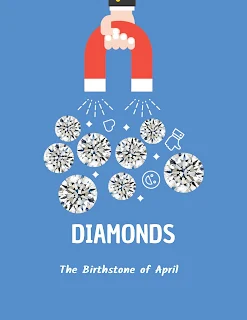Diamond gemstones
Diamonds have a rich history and have captivated people for centuries. The name diamond comes from the Greek word adamas, which means unbreakable or invincible. This name fits the stone perfectly because it is the hardest substance found on Earth. The first diamonds were found in India, mined and traded as early as the 4th century BC. However, it wasn't until the 1700s that diamond mining and cutting techniques were developed, leading to the creation of the brilliant cut diamond we know today.
The origin of diamonds
Diamonds form deep in the Earth's mantle, between 140 and 190 kilometers below the surface. They are created under intense heat and pressure, where carbon atoms crystallize into a unique diamond structure. Most diamonds found today are over a billion years old and were brought to Earth's surface by volcanic activity.
Diamond mythology
Diamonds were attributed to magical properties and were believed to have healing powers in many cultures. In ancient Hinduism, it was believed that lightning strikes created diamonds, and in ancient Greece, they were the tears of the gods. Many cultures believed that wearing diamonds brought good luck and warded off evil spirits.
Famous diamond gemstones
Several famous diamonds have captured the public's imagination. The Hope diamond, a 45.52-carat blue diamond, is one of the most famous diamonds in the world, with a history dating back to the 1600s. The largest diamond ever discovered, the Cullinan Diamond, weighed 3,106 carats in its rough form and was cut into nine main gems, including the Great Star of Africa and the Little Star of Africa.
Gemological properties of diamonds
Diamonds have unique gemological properties that make them very valuable. They are the hardest natural substance on Earth and have a high refractive index, which gives them a distinctive shine. Diamonds also have high thermal conductivity, meaning they dissipate heat quickly, making them useful in many industrial applications.
Diamond Recognition
Diamonds can be identified by their physical properties, including their hardness, density, and refractive index. They also have a clear crystal structure that can be observed under a microscope. Gemologists use special equipment to identify and grade diamonds, including a magnifying glass, which is a magnifying lens, and a refractometer, which measures the refractive index of the gemstone.
What is a natural diamond stone?
A natural diamond is a diamond that was formed in the Earth's mantle and brought to the surface by volcanic activity. Natural diamonds are highly valued for their rarity and unique properties. On the other hand, synthetic diamonds are created in a laboratory and have similar physical and chemical properties to natural diamonds.
How do you recognize the quality and grade of diamonds?
Diamonds are graded based on their 4Cs: carat weight, color, clarity, and cut. Carat weight refers to the weight of the diamond, while color refers to the presence or absence of color in the stone. Clarity refers to the number and type of inclusions or blemishes in a diamond, and cut refers to the quality of the diamond's cut, including its symmetry and proportions. All of these factors contribute to the overall value of a diamond and can be used to identify the quality and grade of the stone.
Buying diamonds
When buying diamonds, it's essential to do your research and buy from a reputable dealer. Look for diamonds certified by a reputable gemological laboratory and request a grading report.
Care of diamond gemstones
Diamonds are one of the world's most complex and durable gems, but that doesn't mean they don't need care and attention. Here are some tips on how to care for a diamond:
Cleaning: Regular cleaning is essential to keep your diamond looking its best. You can clean your diamond with a soft brush and a mixture of warm water and mild soap. You can also use a specialized jewelry cleaning solution. Avoid harsh chemicals and ultrasonic cleaners as they can damage the stone.
Storage: When not wearing the diamond, store it in a clean, dry place away from other jewelry to prevent scratches. You can use a jewelry box or a soft purse.
Avoid chemicals: Diamonds are complex, but chemicals can still damage them. Avoid exposing the diamond to harsh chemicals such as bleach, chlorine, and sulfuric acid. These chemicals can damage the metal around which it is embedded and even cause the diamond to lose its luster.
Protect your diamond: Remove diamond jewelry to avoid damage when doing household chores or playing sports. Diamonds can chip or crack if you hit them hard enough, so it's essential to be careful.
Regular Inspections: Inspect your diamond regularly for signs of damage or wear. If you notice any chips or cracks, take them to a professional jeweler for repair.
You can keep your diamond beautiful for years by following these simple steps.
Copyright © 2023-2024 ValentinsJewellery. All rights reserved.

Comments
Post a Comment